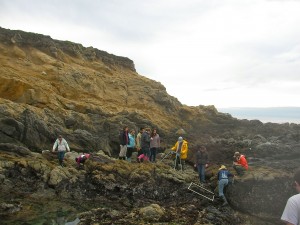|
As a student in Earth Systems’ oceans track, it would be quite unfortunate if I couldn’t say that I like learning about what goes on under the sea. And I do like thinking about the marine world; I like coming to those realizations of just how important the ocean is to our global homeostasis. I have enjoyed gaining a greater understanding of it through courses such as physical oceanography or marine biogeochemistry—in fact, I think it’s really important that we can take classes on Stanford’s campus about the processes that govern 70 percent of the Earth’s surface. But I also think that those theoretical understandings pack more punch when they’re anchored to something a little more concrete. Which is why I love that we also have the opportunity to study at Stanford’s Hopkins Marine Station in Pacific Grove. Studying at Hopkins means getting to go poke around tide pools for class, using science as an excuse to get back in touch with your five-year-old self. I can’t deny that I find it just as wonderful now as I did then that the ocean draws back from the rocky shore about twice a day, unveiling organisms more surreal and captivating than I, for one, could possibly imagine. I still can’t help breaking out into a broad smile as I lean over an Anthopleura sola—a giant green sea anemone with radial lines emanating from its mouth—or giggle as I dip my hand into its cool, shallow pool and feel it gently stick to me as it fires the nematocysts that help it catch its prey into the callus on my finger. It’s a more-than-theoretical, but still hard to grasp, reminder of the staggering number of possible forms life has managed to find on this earth. One that makes me think of Steinbeck’s advice from The Log from the Sea of Cortez to, “look from the tide pools to the stars and then back to the tide pools again.” Studying at Hopkins also means getting to go snorkeling or SCUBA diving on weekends, during those awkward gaps between classes, or sometimes even on a field trip for class. It means immersing yourself in the very thing you are studying, in the most literal sense possible, and gaining insights into the adaptations that allow marine life to thrive. It becomes a lot easier to remember the role of a fish’s swim bladder when you’ve tinkered with a BCD in order to get your buoyancy just right; it’s harder to make fun of the harbor seals flopping around on the beach when you’ve attempted (and failed) to get in and out of the water gracefully while clad in eight millimeters of neoprene. Studying at Hopkins means having 24-hour access to what is, in my opinion, Stanford’s best library. Not only is almost every marine reference you might wish to use meticulously organized within Harold A. Miller’s walls, I’ve found that writing and reading papers becomes so much easier when you can structure your sentences or reflect upon their meaning while looking out the window at the waves crashing down on the California coast. And, of course, spending a quarter at Hopkins also means having the privilege to interact with some of the country’s front-lining marine scientists on a daily basis. Witnessing their enthusiasm for a particular topic, learning about their current research and seeing it in process motivates engaging in an intellectual immersion of everything marine that almost rivals the physical one of jumping in the water. Originally published in Sussing Sustainability at Stanford (SUSS): http://suss.stanford.edu/blog/?p=3825 |
Samantha's
Archives
July 2016
Categories
All
|

 RSS Feed
RSS Feed